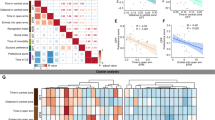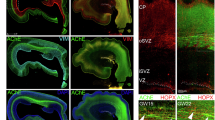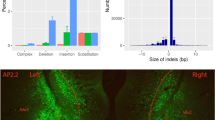Abstract
The ability of nicotine to alter firing of dopamine neurons is the first step leading to nicotine reward, but activation of intracellular signaling pathways downstream of nicotinic acetylcholine receptors is likely to be critical for longer-term consequences of nicotine exposure, including conditioned reward. The transcription factor cyclic AMP-response element binding protein (CREB) is important for new gene transcription and in its phosphorylated form (pCREB) promotes long-term changes in synaptic strength. Previous studies have implicated nucleus accumbens (NAc) CREB activity in the modulation of cocaine and morphine reward, and have shown that nicotine conditioned place preference (CPP) is associated with NAc CREB activation. It is not clear whether CPP elicits phosphorylation of CREB or if elevations in pCREB support nicotine CPP. In the current study, we investigated levels of CREB and pCREB during Pavlovian conditioning with nicotine in a novel context in the absence of chamber choice. Nicotine context conditioning resulted in elevated pCREB levels in the NAc shell but not the NAc core of mice following placement in the nicotine-paired chamber in the absence of nicotine. To test if CREB activity in the NAc shell contributes to cue-induced responses that may precipitate nicotine-seeking, we used viral-mediated gene transfer of a dominant-negative CREB construct in the NAc shell of C57BL/6J mice and found that disruption of CREB activation before training blocked nicotine place preference across a range of doses. Taken together, these studies identify the NAc shell as a brain region where CREB activity is essential for nicotine CPP.
Similar content being viewed by others
Log in or create a free account to read this content
Gain free access to this article, as well as selected content from this journal and more on nature.com
or
References
Barrot M, Olivier JD, Perrotti LI, DiLeone RJ, Berton O, Eisch AJ et al (2002). CREB activity in the nucleus accumbens shell controls gating of behavioral responses to emotional stimuli. Proc Natl Acad Sci USA 99: 11435–11440.
Brody AL, Olmstead RE, London ED, Farahi J, Meyer JH, Grossman P et al (2004). Smoking-induced ventral striatum dopamine release. Am J Psychiatry 161: 1211–1218.
Brunzell DH, Russell DS, Picciotto MR (2003). In vivo nicotine treatment regulates mesocorticolimbic CREB and ERK signaling in C57Bl/6J mice. J Neurochem 84: 1431–1441.
Carlezon Jr WA, Duman RS, Nestler EJ (2005). The many faces of CREB. Trends Neurosci 28: 436–445.
Carlezon Jr WA, Thome J, Olson VG, Lane-Ladd SB, Brodkin ES, Hiroi N et al (1998). Regulation of cocaine reward by CREB. Science 282: 2272–2275.
Choi KH, Whisler K, Graham DL, Self DW (2006). Antisense-induced reduction in nucleus accumbens cyclic AMP response element binding protein attenuates cocaine reinforcement. Neuroscience 137: 373–383.
Corrigall WA, Franklin KB, Coen KM, Clarke PB (1992). The mesolimbic dopaminergic system is implicated in the reinforcing effects of nicotine. Psychopharmacology (Berl) 107: 285–289.
David SP, Munafo MR, Johansen-Berg H, Mackillop J, Sweet LH, Cohen RA et al (2007). Effects of acute nicotine abstinence on cue-elicited ventral striatum/nucleus accumbens activation in female cigarette smokers: a functional magnetic resonance imaging study. Brain Imaging Behav 1: 43–57.
Day JJ, Roitman MF, Wightman RM, Carelli RM (2007). Associative learning mediates dynamic shifts in dopamine signaling in the nucleus accumbens. Nat Neurosci 10: 1020–1028.
Di Chiara G, Bassareo V, Fenu S, De Luca MA, Spina L, Cadoni C et al (2004). Dopamine and drug addiction: the nucleus accumbens shell connection. Neuropharmacology 47 (Suppl 1): 227–241.
Di Chiara G, Imperato A (1988). Drugs abused by humans preferentially increase synaptic dopamine concentrations in the mesolimbic system of freely moving rats. Proc Natl Acad Sci USA 85: 5274–5278.
Due DL, Huettel SA, Hall WG, Rubin DC (2002). Activation in mesolimbic and visuospatial neural circuits elicited by smoking cues: evidence from functional magnetic resonance imaging. Am J Psychiatry 159: 954–960.
Franklin TR, Wang Z, Wang J, Sciortino N, Harper D, Li Y et al (2007). Limbic activation to cigarette smoking cues independent of nicotine withdrawal: a perfusion fMRI study. Neuropsychopharmacology 32: 2301–2309.
Gomperts BD, Tatham PER, Kramer IM (2002). Signal Transduction. Academic Press: San Diego, California.
Josselyn SA, Nguyen PV (2005). CREB, synapses and memory disorders: past progress and future challenges. Curr Drug Targets CNS Neurol Disord 4: 481–497.
Kenney JW, Gould TJ (2008). Modulation of hippocampus-dependent learning and synaptic plasticity by nicotine. Mol Neurobiol 38: 101–121.
Kim JJ, Fanselow MS (1992). Modality-specific retrograde amnesia of fear. Science 256: 675–677.
Lai S, Lai H, Page JB, McCoy CB (2000). The association between cigarette smoking and drug abuse in the United States. J Addict Dis 19: 11–24.
Le Foll B, Goldberg SR (2005). Control of the reinforcing effects of nicotine by associated environmental stimuli in animals and humans. Trends Pharmacol Sci 26: 287–293.
Levin ED, McClernon FJ, Rezvani AH (2006). Nicotinic effects on cognitive function: behavioral characterization, pharmacological specification, and anatomic localization. Psychopharmacology (Berl) 184: 523–539.
Li MD, Lou XY, Chen G, Ma JZ, Elston RC (2008). Gene–gene interactions among CHRNA4, CHRNB2, BDNF, and NTRK2 in nicotine dependence. Biol Psychiatry 64: 951–957.
McClernon FJ, Kozink RV, Rose JE (2008). Individual differences in nicotine dependence, withdrawal symptoms, and sex predict transient fMRI-BOLD responses to smoking cues. Neuropsychopharmacology 33: 2148–2157.
McClung CA, Nestler EJ (2003). Regulation of gene expression and cocaine reward by CREB and DeltaFosB. Nat Neurosci 6: 1208–1215.
McGeehan AJ, Olive MF (2003). The mGluR5 antagonist MPEP reduces the conditioned rewarding effects of cocaine but not other drugs of abuse. Synapse 47: 240–242.
Miller CA, Marshall JF (2005). Molecular substrates for retrieval and reconsolidation of cocaine-associated contextual memory. Neuron 47: 873–884.
Nestler EJ (2005). Is there a common molecular pathway for addiction? Nat Neurosci 8: 1445–1449.
Pandey SC, Roy A, Xu T, Mittal N (2001). Effects of protracted nicotine exposure and withdrawal on the expression and phosphorylation of the CREB gene transcription factor in rat brain. J Neurochem 77: 943–952.
Phillips RG, LeDoux JE (1992). Differential contribution of amygdala and hippocampus to cued and contextual fear conditioning. Behav Neurosci 106: 274–285.
Picciotto MR, Zoli M, Rimondini R, Lena C, Marubio LM, Pich EM et al (1998). Acetylcholine receptors containing the beta2 subunit are involved in the reinforcing properties of nicotine. Nature 391: 173–177.
Pittenger C, Huang YY, Paletzki RF, Bourtchouladze R, Scanlin H, Vronskaya S et al (2002). Reversible inhibition of CREB/ATF transcription factors in region CA1 of the dorsal hippocampus disrupts hippocampus-dependent spatial memory. Neuron 34: 447–462.
Pluzarev O, Pandey SC (2004). Modulation of CREB expression and phosphorylation in the rat nucleus accumbens during nicotine exposure and withdrawal. J Neurosci Res 77: 884–891.
Robbins TW, Everitt BJ (2002). Limbic-striatal memory systems and drug addiction. Neurobiol Learn Mem 78: 625–636.
Roberts DC, Koob GF, Klonoff P, Fibiger HC (1980). Extinction and recovery of cocaine self-administration following 6-hydroxydopamine lesions of the nucleus accumbens. Pharmacol Biochem Behav 12: 781–787.
Robinson TE, Berridge KC (1993). The neural basis of drug craving: an incentive-sensitization theory of addiction. Brain Res Brain Res Rev 18: 247–291.
Robinson TE, Berridge KC (2003). Addiction. Annu Rev Psychol 54: 25–53.
Schiltz CA, Kelley AE, Landry CF (2005). Contextual cues associated with nicotine administration increase arc mRNA expression in corticolimbic areas of the rat brain. Eur J Neurosci 21: 1703–1711.
Schroeder BE, Binzak JM, Kelley AE (2001). A common profile of prefrontal cortical activation following exposure to nicotine- or chocolate-associated contextual cues. Neuroscience 105: 535–545.
Schultz W, Dayan P, Montague PR (1997). A neural substrate of prediction and reward. Science 275: 1593–1599.
Silva AJ, Kogan JH, Frankland PW, Kida S (1998). CREB and memory. Annu Rev Neurosci 21: 127–148.
Spina L, Fenu S, Longoni R, Rivas E, Di Chiara G (2006). Nicotine-conditioned single-trial place preference: selective role of nucleus accumbens shell dopamine D1 receptors in acquisition. Psychopharmacology (Berl) 184: 447–455.
Volkow ND, Wang GJ, Telang F, Fowler JS, Logan J, Childress AR et al (2008). Dopamine increases in striatum do not elicit craving in cocaine abusers unless they are coupled with cocaine cues. Neuroimage 39: 1266–1273.
Walters CL, Blendy JA (2001). Different requirements for cAMP response element binding protein in positive and negative reinforcing properties of drugs of abuse. J Neurosci 21: 9438–9444.
Walters CL, Brown S, Changeux JP, Martin B, Damaj MI (2006). The beta2 but not alpha7 subunit of the nicotinic acetylcholine receptor is required for nicotine-conditioned place preference in mice. Psychopharmacology (Berl) 184: 339–344.
Walters CL, Cleck JN, Kuo YC, Blendy JA (2005). Mu-opioid receptor and CREB activation are required for nicotine reward. Neuron 46: 933–943.
Acknowledgements
We thank J Chang, C Kochevar, Y Pham, B Schneider and C Wein for technical assistance, and William A Carlezon for thoughtful comments on this paper. This work was supported by National Institutes of Health grants AA15632, DA14241, DA10455, a Lieber NARSAD Young Investigator Award to DHB, and DA00436 to MRP. We especially thank Constance and Steven Lieber for their generous support of this work through NARSAD.
Author information
Authors and Affiliations
Corresponding author
Additional information
DISCLOSURE/CONFLICT OF INTEREST
The authors have no financial conflicts of interest with any data or original ideas presented in this paper. DH Brunzell and RL Neve are supported by the National Institute of Health (NIH) for projects unrelated to the work presented in this paper. YS Mineur is supported by the National Institute of Health and by a Pfizer contract for an unrelated project. In addition to the NIH support of this work and other projects, MR Picciotto has received funding from Pfizer for unrelated research endeavors. YS Mineur and MR Picciotto have a patent on cytisine derivatives as novel treatments for depression.
Supplementary Information accompanies the paper on the Neuropsychopharmacology website (http://www.nature.com/npp)
Supplementary information
Rights and permissions
About this article
Cite this article
Brunzell, D., Mineur, Y., Neve, R. et al. Nucleus Accumbens CREB Activity is Necessary for Nicotine Conditioned Place Preference. Neuropsychopharmacol 34, 1993–2001 (2009). https://doi.org/10.1038/npp.2009.11
Received:
Revised:
Accepted:
Published:
Issue date:
DOI: https://doi.org/10.1038/npp.2009.11
Keywords
This article is cited by
-
The acute effects of nicotine on corticostriatal responses to distinct phases of reward processing
Neuropsychopharmacology (2020)
-
Crucial Role of Dopamine D2 Receptor Signaling in Nicotine-Induced Conditioned Place Preference
Molecular Neurobiology (2019)
-
1H-Nuclear magnetic resonance-based metabolomic analysis of brain in mice with nicotine treatment
BMC Neuroscience (2014)
-
Inhibition of phosphodiesterase10A attenuates morphine-induced conditioned place preference
Molecular Brain (2014)
-
Evidence from mouse and man for a role of neuregulin 3 in nicotine dependence
Molecular Psychiatry (2014)



